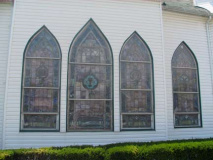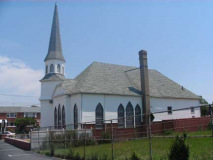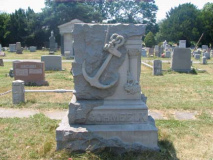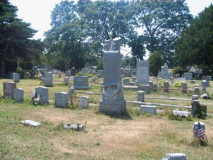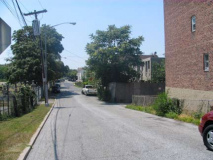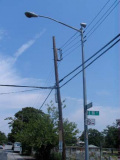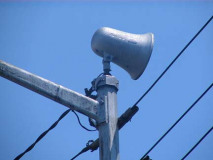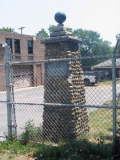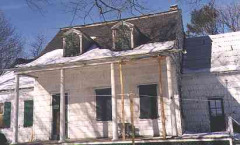Continued from Part 1
Though its exterior has been renovated in recent years, heavy on the aluminum siding, Grace Church (now known as Church At The Rock) on East 92nd Street just south of Avenue J, is a Canarsie touchstone and a beloved local landmark. The Methodist Protestant Church of Canarsie, since renamed Grace, was founded in 1839.
Canarsie Cemetery
Today’s Canarsie Cemetery, between Church Lane, Avenue K, Remsen Avenue and a right-of way roughly along East 85th Street, doesn’t turn up on Canarsie’s older maps before the 1880s. It was originally the churchyard of the Methodist Protestant Church and was located immediately behind the church on East 91st, but by the 1880s the church had acquired more property from the landholding Remsen family (of Remsen Avenue fame).
A stroll in the cemetery, which has become nondenominational and is well-cared for, will reveal names of some of early Canarsie families, such as the Skidmores, Schencks and Remsens.
Road to Lott’s House
Though I’m happy to report that Varkens Hook Road (see Part 1) has retained its original name, there’s another Canarsie road that I wish had kept its more colorful older moniker…
Above: cobblestone fencepost at Canarsie Cemetery’s closed back entrance, Church Lane.
Church Lane runs continuously from East 87th to East 92nd (though the easternmost block is now the parking lot for the Church @ The Rock). There is another piece between East 83rd and East 84th. It forms the northern boundary of Canarsie Cemetery — and is now in considerably better shape than it was when I first saw it in the 1970s, when it was a dirt road that was almost always awash in mud.
The road to Judge John Lott’s farm (located in the western part of town at about Avenue K and East 86th Street) was laid out in 1866 and skirted the northern edge of Canarsie Cemetery. That portion was later renamed Church Lane, but traces of the Road to Lott’s House can be found anywhere between East 83 and East 92 Streets south of Avenue J. The John Lott house was torn down in the late 1980s.
The Lotts were an early colonial Kings County landholding family. Many Brooklyn roads and streets, extinct and extant, were named for family members. Several Lott homes could be found in East Flatbush, Marine Park and Canarsie; at present, only the Hendrick I. Lott house, on East 36th Street between Fillmore Avenue and Avenue S, remains today. The building was completed in 1800 (incorporating an earlier 1720 dwelling) and is notable for containing evidence that slaves once resided in the house; however, the Lotts here freed their slaves in about 1805, well before NY State abolished slavery in 1827.
A thorough archeological dig has been done at the Hendrick Lott house.
I discovered an archeological trove of my own along Church Lane: several old-style mercury vapor lamps are mounted on the lampposts and within the cemetery. I’m not sure if these still work, though.
Let Us Now Praise Famous Restaurants
At Grabstein’s Delicatessen in the Canarsie section of Brooklyn, the pastrami is as moist and peppery as ever and the waiter Harvey Wyler still needles the notoriously demanding customers. But the hustle-bustle days when several waiters pirouetted among the teeming Formica tables and takeout lines would snake along the steamy glass display case are gone. NY Times, May 15, 1996. By the time I obtained these shots on March 23, 2000 Grabstein’s was gone.
The Nathan’s that never was: Coney Island Joe’s (Linden Blvd. just west of the LIRR overpass), now closed. Though never much more than a tiny yellow and red cinderblock shack, Coney Island Joe’s specialized in a manwich-sized version of a regular frank, a legend in its time, or at least circa 1952, when the place first opened. Joe’s drew crowds with a variant of the elusive “double dog” — 2 hot dogs served on a hunk of baguette, a maneuver rarely attempted in New York; a dog some say is best left to New Jersey. The loaded, self-service fixins bar at Joe’s was equally famous, offering up sour pickles and hot peppers. All this is now gone. The abandoned Coney Island Joe’s is fenced in and shuttered; the sprawling Linden subway car repair shop currently dwarfs the small building, crowding it with its own barbed wire fencing. Hugh Merwin, Gothamist
Avenue L
Next came a walk down Canarsie’s second major business street (after Rockaway Parkway), Avenue L…
…found a long-stopped classic clock at an auto repair place on East 92nd Street…
A new batch of retro-lamps have been mounted on telephone poles along Avenue L. These are unique to NYC, so far; I haven’t seen this style elsewhere.
An apartment building between East 93-94 Streets looks nondescript, except for the thicket of cell phone towers…but a closer look reveals Zirkin’s, a long-lost business.
The 1471-seat Canarsie Theatre, Avenue L and East 93rd, opened in 1927. After it closed in 2004, the Canarsie was gutted and began conversion into a banquet hall in 2005, though it seems as if the conversion has come to a halt. The Country Kitchen deli next door was also incorporated into the hall. The closest theatres now are at the Linden Blvd. multiplex near the Queens border or at Kings Plaza at Flatbush Avenue and Avenue U.
At the bottom of Canarsie there’s a big, big man…Big John. Like the calligraphy…
Some ancient signage at Jack & Frank’s Barber Shop, Avenue L.
Paved yard and van, East 96th Street between Avenues K and L.
Avenue L and East 96th Street, former synagogue, now Liberty Hall Cathedral of Praise.
Holmes Lane
Holmes Lane is still a dirt road [paved since] that runs from East 95th to East 96th Street between avenues K & L. The earliest Holmes listed in the Canarsie directory, Emmanuel Holmes, was as a fisherman. Rev. Jeremiah Holmes founded the Plymouth Congregational Church in 1880. At the time, the church was on East 92nd Street, between J and K, and was known as St. Paul’s Congregational Church. In 1892, it was renamed Plymouth Congregational Church and was relocated to Rockaway Parkway and Baisley’s Lane when Rev. Samuel Silkworth succeeded Rev. Jeremiah Holmes as the pastor.
Rev. Holmes was the uncle of Reverend Bert Holmes, who served for many years as the pastor of the Plymouth Congregational Church. Rev. Bert Holmes’ family, some of whom fought in the Civil War, lived in Canarsie from the early 1800s. In the 1960s, the church was once again relocated to East 96th Street, between Flatlands Avenue and Avenue J, to clear the site for Canarsie High School’s athletic field. Linda Steinmuller, Canarsie Courier
One of my sources has it that the Holmes were among the first black families in Canarsie.
On my first forays into Canarsie in the 1970s I was amazed to see Holmes Lane still illuminated by a very old lamp, same style as you see at left, still with its old incandescent bulb.
Unfortunately it was replaced by a regulation finned t-pole lamp, with sodium vapor light, by the mid-1980s and I never got a photo of it…
Along Canarsie Road
As mentioned before Canarsie Road was the first major road to bring traffic into Canarsie from the north. It still carries its old name south of Avenue M; north of that, it’s called East 92nd Street.
Schenck Place, one of four streets in Brooklyn named for a prominent landholding family in colonial-era Kings County, one of a cluster of small lanes off Canarsie Road south of Avenue M. The Nicholas Schenck House, built in the 18th Century and once located in today’s Canarsie Beach Park near Schenck Avenue, was dismantled and moved to the Brooklyn Museum, and reassembled there. His grandfather, Jan Martense Schenck, owned an older house in Mill Basin,itself ensconced in the Museum.
The name, by the way is pronounced Skenk.
Matthews Place, one of the few [streets] in the city that changes direction abruptly, was named for John Matthews, who was a justice of the peace. Judge Matthews presided over the trial of farmer John Redfern, who owned 150 pigs and 150 cows , which was a violation of the day’s health code that permitted each resident to own a maximum of five pigs and five cows. Redfern was later accused of feeding swill to the cattle, and selling diseased meat. Steinmuller
St. Jude
St. Jude Roman Catholic Church, Seaview Avenue and Canarsie Road, replaced an older building in 1988. At first, I thought it was window-free, but a side view dispels that notion.
The parish shares your webmaster’s middle name, an apostle also known as Thaddeus by some sources…the patron saint of desperate cases and lost causes, entirely appropriate in my case!
Old maps show St. Jude Place, a one-block road running from Seaview Avenue south to Canarsie Lane, as “Rockaway Avenue.” How can that be, as Rockaway Avenue ends its run at Rockaway Parkway and Foster Avenue, several blocks to the north?
When Rockaway Avenue was first laid out south to Canarsie in 1870 it took the route Rockaway Parkway does today, and when the straight southeast section was given the “parkway” moniker fairly early on, this section was “orphaned.” It encompassed St. Jude Place and the southernmost section of Canarsie Road. St. Jude Place was given its name to avoid confusion with Rockaway Avenue’s main section, which today runs mainly through Brownsville and Bedford-Stuyvesant.
At Seaview Avenue and Rockaway Parkway we find a now-rare Type 8S curved-mast lightpole. These were among the first generation of new octagonal-post lampposts that began to appear on NYC streets in 1950.
The curved-masts, with their distinctive brace, were retired fairly early on in favor of single, straight mast posts and later, cobra-necks (which are seen here in the background).
Canarsie Pier
The jewel in Canarsie’s tiara is Canarsie Pier, originally constructed in 1926 to gauge the possibility of industrial development in Jamaica Bay. It instead became one of the premier fishing locales on Jamaica Bay, along with Cross Bay Bridge. It’s part of the Gateway National Park Recreational Area and, as such, is run by the US National Park Service.
While the pier is very popular with Canarsieans (Canarsieites? Canarsiers?) there’s an abandoned restaurant that has been an eyesore smack in the middle of the pier since 2002, and the cutting boards used by fishermen to clean catches are encrusted with guts and entrails. Any piergoers using the B42 bus down Rock Parkway have a hike to make, since the bus loops, but doesn’t stop here; you have to trudge to Shore Parkway, a good distance away, to board the bus.
Just north of today’s Belt Parkway, which reached Canarsie in 1940, and Canarsie Pier is the site of Golden City Park — Canarsie’s answer to Coney Island which was in business from 1907 to 1934, when the first in a series of devastating fires put it out of business. The coming of the Circumferential (later, “Belt” for the benefit of Canarsie spellers (just kidding!) Parkway in 1939-40 burnt out its last ember.
People who visited, played games, enjoyed a boat ride, The Funhouse, The Roller Coaster, The Miniature Steam Railway, The Circle Swings, The Caterpiller, Penny Arcade, Skooter, The Tunnel of Love, The Whip, The Airplane Ride, a Dance Pavilion and the Carousels amongst other attractions. The two carousels were Murphy’s Carousel and Nunley’s Carousel. Nunley’s Carousel was built in 1912. It was carved by two men from Brooklyn named Stein and Goldstein. The Carousel consisted of an organ, 41 horses and one lion. It was moved to an Amusement Park in Baldwin Long Island in 1939. The visitors also enjoyed the surrounding beaches, the Boardwalk (on Seaview Avenue) and all of the refreshments, from soda, beer, hot dogs, seafood and other assorted varieties. Given the proximity of the water and the best fishing and clamming area on the entire Eastern seaboard, seafood was undoubtedly the most sought after food. A boxing arena was one of the most exciting attractions outside the parkís entrance. Also outside the park, located near the train station, stood the famous Husman Music Hall along with some hotels and beer halls. Old Canarsie, where there’s a nice selection of Golden City Park photos
That about takes care of it for now, but we haven’t seen Canarsie north of the subway terminal, which we will on a future FNY page.
Photographed July 19, 2008; page completed July 27
Thanks to all publications and websites linked on these pages. A comprehensive history of the Canarsie Line can be found in William Fausser’s The Brooklyn and Rockaway Beach Railroad — very hard to find these days.

